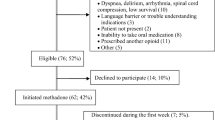Abstract
A consecutive sample of patients who were switched from strong opioids to methadone in a period of 1 year was surveyed. QTc was assessed before switching (T0) and after achieving adequate analgesia and an acceptable level of adverse effects (Ts). Twenty-eight of 33 patients were switched to methadone successfully. The mean initial methadone doses at T0 were 67.1 mg/day (SD ±80.2, range 12–390). The mean QTc interval at T0 was 400 ms (SD ±30, range 330–450). The mean QTc interval at Ts (median 5 days) was 430 ms (SD ±26, range 390–500). The difference (7.7 %) was significant (p < 0.0005). Only two patients had a QTc of 500 ms. No serious arrhythmia was observed. At the linear regression analysis, there was no significant association between mean opioid doses expressed as oral morphine equivalents and QTc at T0 (p = 0.428), nor between mean methadone doses and QTc at Ts (p = 0.315). No age differences were found with previous opioid doses (p = 0.917), methadone doses (p = 0.613), QTc at T0 (p = 0.173), QTc at Ts (p = 0.297), and final opioid–methadone conversion ratio (p = 0.064). While methadone used for opioids switching seems to be an optimal choice to improve the opioid response in patients poorly responsive to the previous opioid, the possible QTc prolongation should be of concern despite not producing clinical consequences in this group of patients. A larger number of patients should be assessed to quantify the risk of serious arrhythmia.
Similar content being viewed by others
References
Caraceni A, Hanks G, Kaasa S (2012) Use of opioid analgesics in the treatment of cancer pain: evidence-based recommendations from the EAPC. Lancet Oncol 13:e58–e68
Cruciani R, Sekine R, Homel P (2005) Measurement of QTc in patients receiving chronic methadone therapy. J Pain Symptom Manage 29:385–391
Cruciani R (2008) Methadone: to ECG or not ECG… That is still the question. J Pain Symptom Manage 36:545–552
Florian J, Garnett CE, Nallani SC, Rappaport BA, Throckmorton DC (2012) A modeling and simulation approach to characterize methadone QT prolongation using pooled data from five clinical trials. Clin Pharmacol Ther 91:666–672
Fredheim OM, Borchgrevink PC, Hrgrenaes L, Kaasa S, Dale O, Klepstad P (2006) Opioid switching from morphine to methadone causes a minor but not clinically significant increase in QTc time: a prospective 9-month follow-up study. J Pain Symptom Manage 32:180–185
Gourevitch M (2009) First do not harm…. reduction? Ann Intern Med 150:417–418
Kornick CA, Kilborn MJ, Santiago-Palma J et al (2003) QTc interval prolongation associated with intravenous methadone. Pain 105:499–506
Krantz MJ, Lewkowlez L, Hays H, Woodroffe M, Robertson A (2002) Torsades de points associated with very-high dose methadone. Ann Intern Med 137:501–504
Krantz MJ, Lowery C, Martell B, Gourevitch M, Arnsten J (2005) Effects of methadone on QT-interval dispersion. Pharmacotherapy 25:1523–1529
Krantz MJ (2008) Heterogeneous impact of methadone on the QTc interval: what are the practical implications? J Addict Dis 27:5–9
Krantz MJ, Martin J, Stimmel B, Mehta D, Haigney MC (2009) QTc interval screening in methadone treatment. Ann Intern Med 150:387–395
Maremmani I, Pacini M, Cesaroni C et al (2005) QTc interval prolongation in patients on long-term methadone maintenance therapy. Eur Addict Res 11:44–49
Martell B, Arnsten J, Ray B, Gourevitch M (2003) The impact of methadone induction on cardiac conduction in opiate users. Ann Intern Med 139:154–155
Martell B, Arnsten J, Ray B, Krantz M, Gourevitch M (2005) Impact of methadone treatment on cardiac repolarization and conduction in opioid users. Am J Cardiol 95:915–918
Mayet S, Gossop M, Lintzeris N, Markides V, Strang J (2011) Methadone maintenance, QTc and torsade de pointes: who needs an electrocardiogram and what is the prevalence of QTc prolongation? Drug Alcohol Rev 30:388–396
Mercadante S (2012) Switching methadone: a 10-year experience of 345 patients in an acute palliative care unit. Pain Med 13:399–404
Mercadante S, Ferrera P, Villari P, Casuccio A, Intravaia G, Mangione S (2009) Frequency, indications, outcomes, and predictive factors of opioid switching in an acute palliative care unit. J Pain Symptom Manage 37:632–641
Mercadante S, Bruera E (2006) Opioid switching: a systematic and critical review. Cancer Treat Rev 32:304–315
Mercadante S, Caraceni A (2011) Conversion ratios for opioid switching in the treatment of cancer pain: a systematic review. Palliat Med 25:504–515
Ministero della salute. (2003) Bollettino di informazione sui farmaci, anno X, n-5.6.
Ower K, Morley-Forster P, Moulin D (2005) Fluctuating QTc interval in an asymptomatic patient treated with methadone for chronic pain. J Opioid Manage 1:73–76
Pearson EC, Woosly R (2005) QT prolongation and torsades de pointes among methadone users; report to the FDA spontaneous reporting system. Pharmacoepidemiol Drug Saf 14:747–753
Peles E, Bodner G, Kreek M, Rados V, Adelson M (2006) Corrected-QT intervals as related to methadone dose and serum level in methadone maintenance treatment (MMT) patients—a cross-sectional study. Addiction 102:289–300
Reddy S, Fisch M, Bruera E (2004) Oral methadone for cancer pain: no indication of QT interval prolongation or torsade de pointes. J Pain Symptom Manage 28:301–303
Reddy S, Hui D, El Osta B et al (2010) The effect of oral methadone on the QTc interval in advanced cancer patients: a prospective pilot study. J Palliat Med 13:33–38
Roy AK, McCarthy C, Kiernan G et al (2010) Increased incidence of QT interval prolongation in a population receiving lower doses of methadone maintenance therapy. Addiction 107:1132–1139
Shah RR (2013) Drug-induced QT interval prolongation: does ethnicity of the through QT study population matter? Br J Clin Pharmacol 75:347–358
Conflict of interest
The authors have no conflict of interest to declare.
Author information
Authors and Affiliations
Corresponding author
Rights and permissions
About this article
Cite this article
Mercadante, S., Prestia, G., Adile, C. et al. Changes of QTc interval after opioid switching to oral methadone. Support Care Cancer 21, 3421–3424 (2013). https://doi.org/10.1007/s00520-013-1928-y
Received:
Accepted:
Published:
Issue Date:
DOI: https://doi.org/10.1007/s00520-013-1928-y




